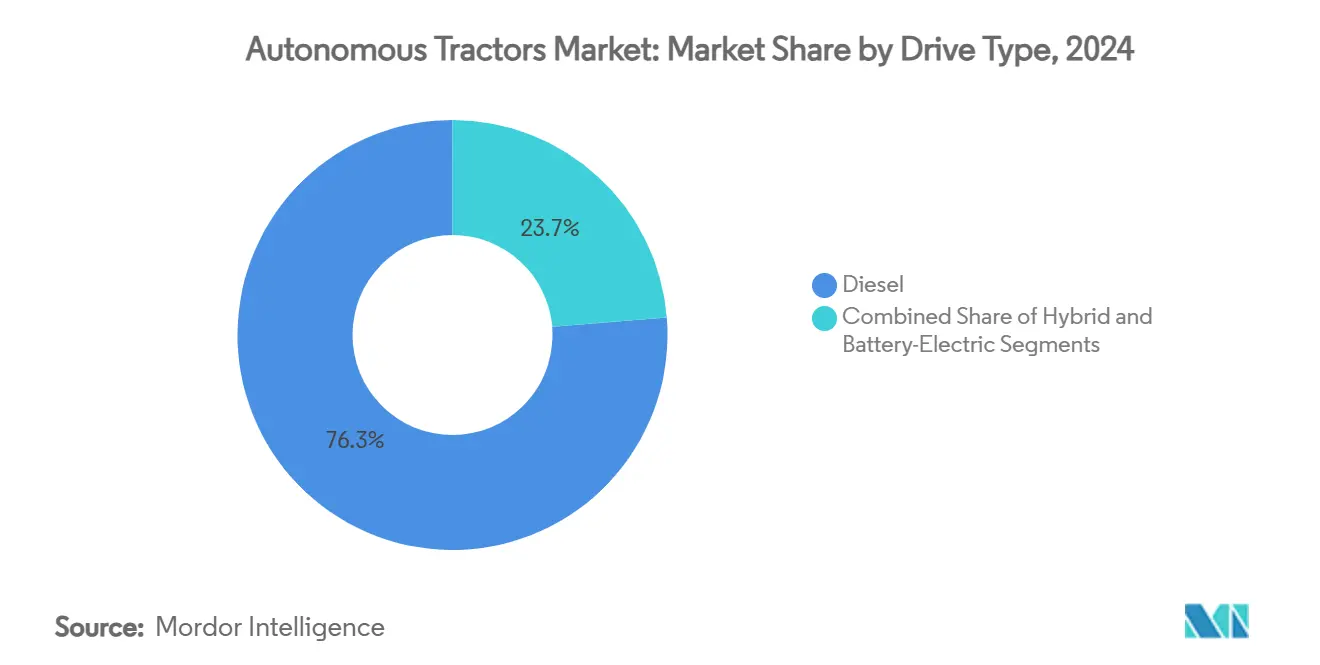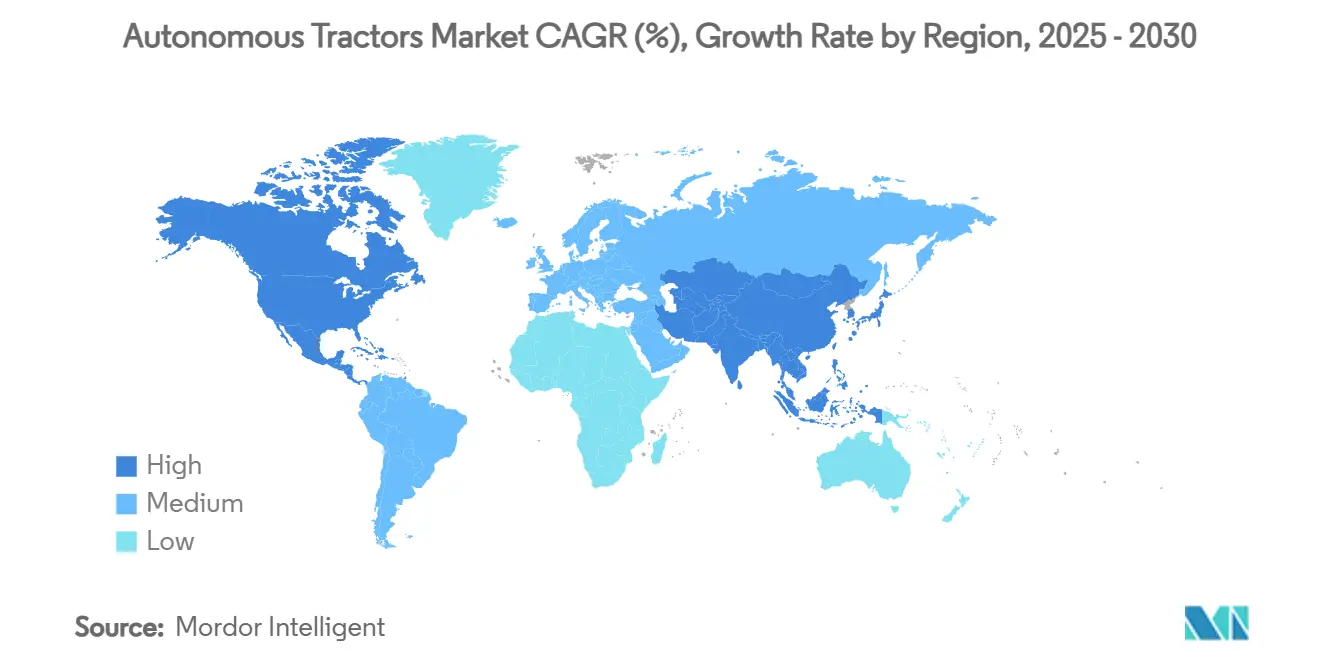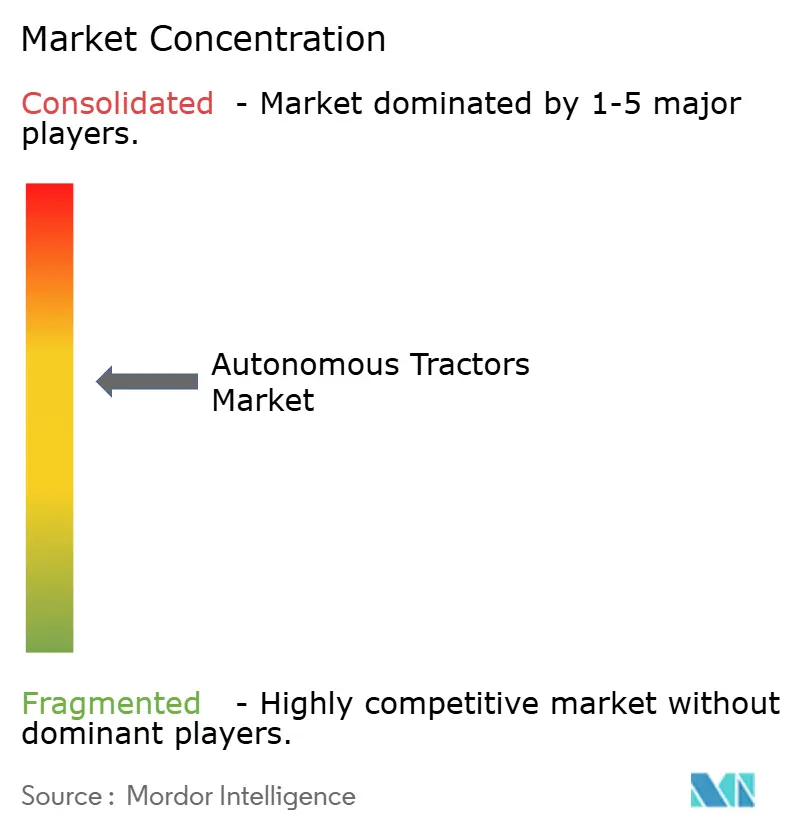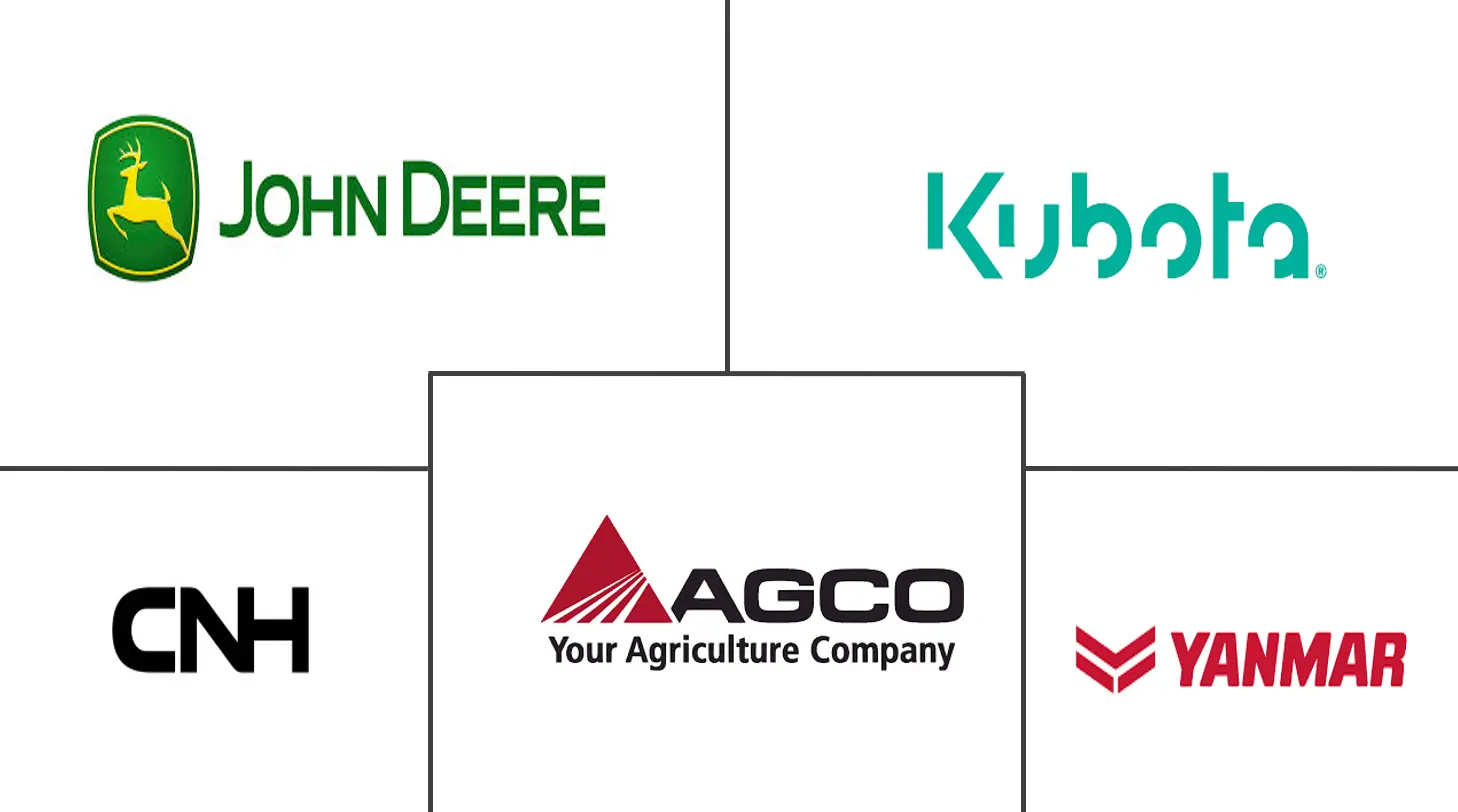Autonomous Tractors Market Size and Share

Autonomous Tractors Market Analysis by Mordor Intelligence
The autonomous tractor market touched USD 2.2 billion in 2025 and is forecast to reach USD 5.2 billion by 2030, sustaining an 18.6% CAGR. The upswing stems mainly from an acute farm-labor crisis, rapid precision-agriculture uptake, and a widening set of government incentives that shorten payback periods for connected low-carbon machinery. Large commercial growers are already converting labor savings of 20% into higher margins, while continuous 24-hour field operation raises seasonal output. Software-centric revenue models, retrofit kits, and electric powertrains further expand addressable demand, signaling that the autonomous tractor market is entering a mainstream growth phase that transcends niche adoption.
Key Report Takeaways
- By automation level, semi-autonomous systems led with 68.2% of autonomous tractor market share in 2024, and fully autonomous platforms are advancing at a 23.1% CAGR through 2030.
- By horsepower, tractors above 31-100 HP held 39.5% share of the autonomous tractor market size in 2024, and units up to more than 100 HP are growing at 24.0% CAGR.
- By drive type, battery-electric models are expanding at 29% CAGR while diesel still commands 76.3% revenue share.
- By application, tillage held 37.4% of the autonomous tractor market size in 2024, and orchard and vineyard uses are set to climb at 28.7% CAGR.
- By Farm Size, Large Farms (>500 ha) held 46.2% of the autonomous tractor market size in 2024, and Medium Farms (100-500 ha) are set to climb at 24.5% CAGR.
- By Component, GPS/GNSS held 35.4% of the autonomous tractor market size in 2024, and Battery-Electric Powertrain Packs are set to climb at 23.2% CAGR.
- By geography, Asia-Pacific led with a 46.3% share in 2024, while North America is projected to record a 23.2% CAGR to 2030.
Global Autonomous Tractors Market Trends and Insights
Drivers Impact Analysis
| Driver | (~) % Impact on CAGR Forecast | Geographic Relevance | Impact Timeline |
|---|---|---|---|
| Rising farm-labor shortages and wage inflation | +1.8% | Global, with acute impact in North America and Europe | Medium term (2-4 years) |
| Accelerated adoption of precision agriculture and IoT connectivity | +1.5% | North America and the EU leading, Asia-Pacific following | Long term (≥ 4 years) |
| Government incentives for smart and low-carbon equipment | +1.2% | EU and North America core, expanding to Asia-Pacific | Short term (≤ 2 years) |
| Orchard and vineyard shift to narrow-row autonomous tractors | +0.8% | North America, Europe, and Australia specialty crop regions | Medium term (2-4 years) |
| OEM open-API ecosystems enabling retro-fit autonomy | +0.9% | Global, with North America and Europe, early adoption | Medium term (2-4 years) |
| Carbon-credit monetization for electric autonomous units | +0.6% | European Union and California leading, expanding globally | Long term (≥ 4 years) |
| Source: Mordor Intelligence | |||
Rising Farm-Labor Shortages and Wage Inflation
A shrinking rural workforce is colliding with rising average farmer age, leaving half of open agricultural roles unfilled. Wage inflation amplifies the strain during peak field windows, particularly for harvest, where autonomous grain-cart systems now run round-the-clock without operators[1]Source: John Deere, “CES 2025 Product Launch Overview,” deere.com. Growers report productivity gains of 30–40% during critical windows, confirming that the autonomous tractor market is filling a structural gap rather than adding discretionary convenience. The urgency has reframed autonomy as core infrastructure required for long-term farm viability.
Accelerated adoption of precision agriculture and IoT connectivity
Cloud farm-management platforms already link well over 1 million machines, converting tractors into roaming data hubs that feed soil, yield, and asset information into real-time decision systems. Advanced sensor fusion, GPS, machine vision, and radar enable centimeter-level guidance, variable-rate input placement, and full-field obstacle avoidance[2]Source: Federal Communications Commission, “Precision Agriculture Connectivity Report,” fcc.gov.
Government incentives for smart and low-carbon equipment
Targeted subsidies now cover up to 50% of the purchase price for electric autonomous tractors in several U.S. states, while the European Union is embedding autonomy within post-2027 Common Agricultural Policy guidelines. Precision agriculture grants in the U.S. Midwest mandate minimum 100/20 Mbps farm connectivity, accelerating broadband deployment that, in turn, raises the total addressable autonomous tractor market. Such incentives compress payback cycles, pushing autonomy onto capital-budget priority lists.
Orchard and vineyard shift to narrow-row autonomous tractors
Specialty-crop operations face labor costs that often top 40% of production outlay. Purpose-built narrow tractors equipped with LiDAR now navigate dense foliage safely, trimming headcount and reducing operator injury risk. OEMs and startups alike have introduced low-profile, sub-2-meter-wide units that fit between trellises while maintaining centimeter precision, opening fresh revenue pools for the autonomous tractor market in high-value crops.
Restraints Impact Analysis
| Restraint | (~) % Impact on CAGR Forecast | Geographic Relevance | Impact Timeline |
|---|---|---|---|
| High upfront cost and uncertain ROI for small farms | -1.1% | Global, particularly acute in developing markets | Short term (≤ 2 years) |
| Data privacy and cybersecurity concerns in connected fleets | -0.7% | North America and European Union regulatory focus, global implications | Medium term (2-4 years) |
| Patchy rural 5G/edge connectivity | -0.5% | Rural areas globally, most acute in developing regions | Medium term (2-4 years) |
| Evolving liability regulations for driver-less machinery | -0.4% | North America and European Union regulatory uncertainty | Long term (≥ 4 years) |
| Source: Mordor Intelligence | |||
High upfront cost and uncertain ROI for small farms
A single electric autonomous tractor can exceed USD 88,000, a steep outlay for holdings under 100 hectares. Connectivity upgrades, on-premise data infrastructure, and service subscriptions add further load. Models show that profitable deployment often begins above 500 hectares unless external grants offset capital expense, leaving many family farms to rely on co-operative ownership or hire services until prices fall.
Data-privacy and cybersecurity concerns in connected fleets
Pen-test exercises have exposed vulnerabilities that could let attackers hijack machine controls or lock operators out of cloud platforms during key planting days. Ransomware threats prompted federal agencies to issue sector-specific alerts, and farmers voiced unease over data ownership clauses in equipment licenses. Resolving these issues remains pivotal for fully unleashing the autonomous tractor market.
Segment Analysis
By Horsepower: Smaller Units Propel Market Reach
Current demand centers on tractors above 31-100, which accounted for 39.5% of the autonomous tractor market share in 2024. The mid-range 31–100 HP bracket serves as a pivotal bridge, blending horsepower sufficient for moderate tillage with manageable capital requirements. Modular add-ons, vision kits, telematics, and implementing automation allow progressive autonomy upgrades. Dealers report that growers trial a semi-autonomous retrofit on an existing 75 HP tractor before purchasing a larger 200 HP flagship machine, illustrating a stepped adoption curve.
Yet the spotlight is shifting to more than 100 HP, the fastest-growing slice at 24.0% CAGR. These machines suit broad-acre tillage, seeding, and heavy draft implements on large farms. Compact units up to 30 HP empower horticulture, dairy, and mixed-crop holdings to automate repetitive tasks such as mowing or spraying. Fleet concepts that deploy multiple lightweight robots instead of one heavy tractor lower soil compaction, reduce field entry barriers, and democratize precision technology for smallholders.

Note: Segment shares of all individual segments available upon report purchase
By Automation Level: Transition from Supervised to Full Autonomy
Semi-autonomous configurations, where an operator remains in the cab or oversees the machine remotely, commanded 68.2% market share in 2024. Farmers value immediate labor savings yet retain manual fallback. Over the forecast period, fully autonomous solutions will outpace all others, expanding at 23.1% CAGR. The step-wise path of remote steering aids, task-specific autonomy, and then full fleet orchestration mirrors the automotive sector’s evolution. Real-time kinematic GPS, multi-camera perception, and redundant safety layers underpin Level 4 capabilities now entering commercial fields.
Confidence builds as growers witness a combine run autonomously for 12 straight hours without intervention. Regulators are drafting performance-based guidelines rather than prescribing technology, easing deployment. Insurance carriers have started to offer premium discounts for validated autonomous systems that reduce accident risk.
By Application: Specialty Crops Drive Highest Growth
Tillage held 37.4% of the autonomous tractor market size in 2024 because guidance systems for straight-line draft work are mature and proven. The fastest momentum, however, lies in orchards and vineyards, where CAGR reaches 28.7%. Narrow-row units with LiDAR and machine-vision arrays navigate tight canopy environments, freeing workers from tasks that traditionally absorb long hours.
Harvest and sowing automation trail but are closing the gap. Grain-cart handoff coordination and autonomous transplanting robots demonstrate rising sophistication. Each incremental capability compounds ROI, creating a virtuous cycle where growers reinvest savings into additional autonomous assets, further enlarging the autonomous tractor market.
By Drive Type: Electric Power Gains Momentum
Diesel continues to power 76.3% of units today, yet battery-electric tractors exhibit a robust 29% CAGR as carbon-credit schemes and zero-emission mandates loom. Total-cost-of-ownership modelling shows electric drivetrains can cut operating costs by one-third once charging infrastructure is in place and off-peak electricity pricing is secured. Lighter chassis curb soil compaction by up to 40%, and instant torque improves implement control, especially in specialty crops.
Hybrid models that pair diesel generators with traction batteries provide an interim step, extending runtime in remote fields lacking grid access. Meanwhile, swappable battery packs enable continuous operation: one bank powers the tractor while another recharges at the field edge.

Note: Segment shares of all individual segments available upon report purchase
By Component: Software Generates Disproportionate Value
Onboard control and navigation software forms the brain of autonomous operation, directing sensors, actuators, and implements in real time. GPS/GNSS held 35.4% of the autonomous tractor market size in 2024, and Battery-Electric Powertrain Packs are set to climb at 23.2% CAGR. Though cameras, radar, LiDAR, and RTK antennas provide the raw inputs, it is the algorithm stack, path planning, obstacle classification, and edge inference where competitive differentiation emerges. Firmware updates unlock new features, extending asset life and opening recurring-revenue streams for vendors.
Sensor commoditization shifts bargaining power upstream to developers that integrate data into actionable agronomy. Partnerships between chipset makers and tractor OEMs are proliferating to optimize compute performance per watt, a critical factor for battery-electric machines. Field-level cybersecurity modules now embed encryption at the processor level, guarding against spoofing or remote hijack.
By Farm Size: Scale Economics Dictate Adoption Pace
By Farm Size, Large Farms (>500 ha) held 46.2% of the autonomous tractor market size in 2024, and Medium Farms (100-500 ha) are set to climb at 24.5% CAGR. Holdings exceeding 500 hectares unlock the strongest economics because autonomous tractors can run continuously across extensive acreages, maximizing utilization and amortizing capital at speed. Mid-size farms of 100–500 hectares are entering the market in growing numbers as hardware costs fall and leasing options spread payments over multi-year terms. Smaller farms remain cautious: low annual field hours stretch ROI beyond acceptable limits unless shared-ownership models emerge.
Co-operatives are addressing this gap by purchasing fleets of compact autonomous tractors and offering per-acre services to members. Custom operators likewise see autonomy as a way to run leaner crews and cover more territory during tight planting windows, offering another path for smallholders to benefit indirectly. These patterns ensure that every acreage band ultimately feeds demand and expands the autonomous tractor market toward saturation.
Geography Analysis
Asia-Pacific preserved its leadership with a 46.3% share in 2024, underpinned by sizable land holdings and robust public funding. China’s multi-trillion-dollar pledge to modernize farming injects capital into equipment subsidies, AI research hubs, and rural 5G roll-outs. Japan’s smart-farming drive counters a rapidly aging farmer demographic, while Australia directs grants toward autonomous solutions suited to vast dryland operations. These aligned policies sustain a deep opportunity pool for the autonomous tractor market across the region.
North America is the fastest-expanding arena at 23.2% CAGR. High labor costs, abundant venture capital, and active OEM R&D pipelines speed commercialization. The United States dominates precision agriculture connectivity projects, yet only 27% of farms have adopted them, implying sizable headroom. Federal programs that require minimum broadband speeds per farm accelerate digital foundations needed for autonomy. Canada leans on clean-tech subsidies, and Mexico’s mechanization push spreads automation southward.
Europe follows a steady growth path, supported by Common Agricultural Policy reforms that reward digital, low-carbon farming[3]Source: European Economic and Social Committee, “Digitalising EU Agriculture Post-2027,” eesc.europa.eu. Germany, France, and Spain lead deployments through established machinery makers and strict emission standards that favor electric drive. Eastern Europe offers upside as large tracts of contiguous farmland suit fleet-scale autonomy. Subsidized carbon-credit schemes and energy-transition funds lower the financial hurdle, cementing Europe as a vital segment of the autonomous tractor market.

Competitive Landscape
The autonomous tractor market exhibits moderate consolidation with established agricultural machinery giants leveraging their distribution networks and customer relationships while specialized startups challenge incumbents through innovative technology approaches and targeted applications. Traditional OEMs like John & Company, AGCO, and CNH Industrial pursue software-centric transformation strategies, with John Deere targeting 10% software revenue by 2030 and AGCO's PTx Trimble joint venture aiming for USD 2 billion in precision agriculture revenue by 2028.
These companies compete through comprehensive ecosystem approaches that integrate hardware, software, and services, while newer entrants like Monarch Tractor focus on specific market segments with purpose-built autonomous solutions. The competitive intensity reflects the industry's transition from equipment manufacturing to technology services, where data analytics, AI capabilities, and connectivity platforms increasingly determine market position.
Strategic partnerships and acquisitions accelerate technology development and market access, as demonstrated by CNH Industrial's collaboration with Bluewhite for AI-powered autonomous solutions and Yamaha Motor's acquisition of Robotics Plus to enter the specialty crop automation market. The market structure suggests future consolidation around platform providers who can deliver comprehensive autonomous farming ecosystems rather than standalone equipment manufacturers.
Autonomous Tractors Industry Leaders
-
Kubota Corporation
-
AGCO Corporation
-
John Deere
-
CNH Industrial
-
YANMAR HOLDINGS CO., LTD.
- *Disclaimer: Major Players sorted in no particular order

Recent Industry Developments
- January 2025: John Deere unveiled the 9RX autonomous tractor and 5ML autonomous narrow tractor, each equipped with 16-camera AI systems, during CES 2025.
- January 2025: John Deere launched Next Generation Perception System retrofit kits for 2022-plus 9R, 9RX, 8R, and 8RX models, enabling autonomous tillage.
- July 2024: Monarch Tractor closed a USD 133 million Series C round to scale its MK-V electric autonomous platform.
- May 2024: AGCO highlighted the PTx Trimble OutRun retrofit kit in its 2024 Annual Report, supporting an ambition to reach USD 2 billion precision-ag revenue.
Research Methodology Framework and Report Scope
Market Definitions and Key Coverage
Our study defines the autonomous tractors market as the revenue generated from new, self-propelled agricultural tractors that can operate with no on-board driver for at least one full field cycle by relying on integrated GPS/GNSS, sensor suites, and decision-support software.
Scope Exclusions: retrofitted driver-assist kits sold for existing tractors are not included.
Segmentation Overview
- By Horsepower
- Up to 30 HP
- 31 - 100 HP
- Above 100 HP
- By Automation Level
- Semi-Autonomous
- Fully Autonomous
- By Drive Type
- Diesel
- Hybrid
- Battery-Electric
- By Application
- Tillage
- Sowing
- Harvesting
- Orchard and Vineyard Operations
- By Component
- GPS/GNSS
- Sensors and Vision Systems
- LiDAR and Radar Modules
- Control and Navigation Software
- By Farm Size
- Small ( Less than 100 ha)
- Medium (100-500 ha)
- Large ( More than 500 ha)
- By Geography
- North America
- United States
- Canada
- Mexico
- Rest of North America
- South America
- Brazil
- Argentina
- Rest of South America
- Europe
- Germany
- United Kingdom
- France
- Spain
- Russia
- Rest of Europe
- Asia-Pacific
- China
- India
- Japan
- Australia
- South Korea
- Rest of Asia-Pacific
- Middle East
- Saudi Arabia
- UAE
- Turkey
- Rest of Middle East
- Africa
- South Africa
- Rest of Africa
- North America
Detailed Research Methodology and Data Validation
Primary Research
Interviews with OEM engineers, dealer networks, precision-ag consultants, and growers across North America, Europe, India, and Brazil helped us test sensor cost curves, realistic field-hour utilization, and farm-level payback periods. Survey feedback also fine-tuned adoption lags between semi and fully autonomous platforms.
Desk Research
Analysts first compiled baseline data from open, tier-1 sources such as UN FAO farm-labor statistics, USDA and Eurostat machinery registrations, trade flow tables from UN Comtrade, patent families in Questel, and technical papers in IEEE Xplore that quantify sensor cost trajectories.
Company 10-Ks, investor decks, and reputable ag-equipment trade journals then added color on pricing spreads and regional adoption.
Paid databases, D&B Hoovers for financials and Marklines for OEM shipment splits, supplied firm-level granularity that public sources lack.
Many additional references were reviewed; the list above is illustrative, not exhaustive.
A second sweep validated supply signals: tender notices in Tenders Info, tariff movements, and seasonality notes from Bestsellingcarsblog for high-horsepower tractor demand.
This dual pass ensured every assumption rested on publicly traceable figures before we moved to model building.
Market-Sizing & Forecasting
A top-down demand pool was built from cultivated hectares, tractor density per hectare, and the observed shift rate toward autonomy; results were cross-checked through selective bottom-up roll-ups of sampled average selling price multiplied by unit shipments gathered from channel partners.
Key variables like farm labor index, precision-ag equipment penetration, average ASP per horsepower band, and LiDAR cost deflation feed a multivariate regression that projects market value to 2030.
Where shipment data were partial, regional weighting and historical replacement cycles bridged gaps.
Data Validation & Update Cycle
Outputs undergo variance checks against independent indicators, peer review among two senior analysts, and a manager sign-off.
Models refresh annually; material events such as subsidy rollouts trigger interim updates, and a final pre-publication pass ensures clients receive the latest view.
Why Mordor's Autonomous Tractors Baseline Commands Reliability
Published figures differ because firms choose dissimilar unit definitions, apply varied ASP progressions, and update at different cadences.
Our disciplined scope alignment, annual refresh, and dual-method model reduce those distortions.
Benchmark comparison
| Market Size | Anonymized source | Primary gap driver |
|---|---|---|
| USD 2.20 B (2025) | Mordor Intelligence | - |
| USD 1.86 B (2024) | Global Consultancy A | Regional scope only; excludes semi-autonomous units; biennial refresh |
| USD 2.70 B (2025) | Global Consultancy B | Uses list prices without channel discounts; no primary validation |
The comparison shows that higher values emerge when list prices are used, while lower totals stem from narrowed geography.
By blending validated ASPs with global coverage and yearly updates, Mordor Intelligence delivers a balanced baseline that decision-makers can rely on.
Key Questions Answered in the Report
What is the current valuation of the autonomous tractor market?
The autonomous tractor market is valued at USD 2.2 billion in 2025 and is forecast to reach market size to USD 5.2 billion by 2030.
Which region records the highest autonomous tractor market share today?
Asia-Pacific leads with 46.3% of global revenue owing to sustained public investment and extensive arable land.
Which drive technology is expanding fastest?
Battery-electric autonomous tractors are growing at a 29% CAGR, driven by carbon-credit schemes and lower operating costs.
How quickly are fully autonomous tractors gaining ground?
Fully autonomous platforms are rising at a 23.1% CAGR, outpacing semi-autonomous systems as farmer confidence improves.
Why are specialty crops such as orchards and vineyards key to growth?
Specialty operations face labor costs exceeding 40% of production, narrow-row autonomous tractors cut those costs and boost precision, resulting in a 28.7% CAGR for this application segment.
What main barrier still limits adoption among small farms?
High upfront capital combined with uncertain ROI hinders purchases by farms under 100 hectares, although co-operative ownership and subsidies are easing the burden.
Page last updated on:



